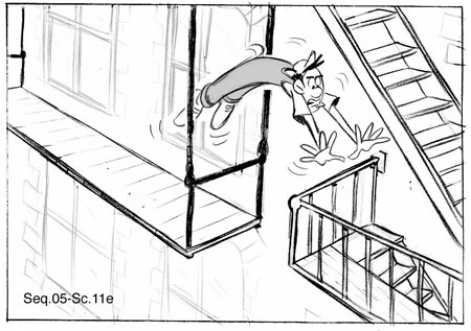However, its gestation is a much more complex and prolonged journey. After all, it started out as an arcade game, way back in 2007.
Indeed, versions of the game made an appearance in the several arcades in the New England region to favourable results, but a lack of publisher interest meant the game - in that form at least - was cancelled in 2008.
Yet, the story, which enables players to determine the actions of Edgar as he attempts to pursue his love interest, Sylvia, and save his brother from an accidental surgery was too good to die.
In this interview, React's principal and co-founder, Dan Kraus, discusses the gameplay implementation, the transition from arcade to iOS and future possibilities on the platform.
Pocket Gamer: Can you describe the origin of the story concept for The Act?
Dan Kraus: In 2003, Omar Khudari - the original author of The Act, and a partner in React Entertainment, envisioned a new kind of entertainment in which classical 2D characters could be made fully interactive. To achieve his vision, Omar founded a company, and hired a team of professional animators.
Omar conceived of the storyline and characters, based on an imaginative plot line hed been creating for years.
Working with the animators, they defined and honed the characters - both their personalities, and their interactions.
How did you decide what gameplay elements would work to interact with the story?
As the original animation team examined the overall script, they identified scenes that they felt they could bring to life with user-controlled animation.

A prime consideration in the choice of these scenes was the fun and comedy factor, since this part of the game had to be truly engaging.
What other gameplay concepts were considered?
While there were other versions of the characters and script, the overall gameplay was always relatively the same - a very simple, interactive control that allowed users to become quickly and easily absorbed into the story and the characters.
What parts of the game had to be changed in bringing it to iOS?
We had to re-write a vast amount of the original code, and define a whole new level of user interaction (the swipe control) for the game. A great deal of effort was put into tuning these controls, to ensure they function completely seamlessly for the user.

We also had significant work around compression and asset adjustment, since the original game was designed to work on a video arcade machine - not a highly-optimised mobile phone or tablet.
Can you describe the process of blending the animations so seamlessly depending on the player's interaction?
Actually, thats part of the secret sauce at the heart of our IP.
I can say that its a non-trivial problem though, and requires both specific changes at the animation design level, and also a good deal of interpolation technology (that took years to develop).
How were they different to the tools originally used to develop The Act?
Completely different. The original game was drawn on paper, scanned in, inked, and then processed for inclusion in the game.
Character interaction was created using a proprietary authoring tool (part of our IP as well), and then rendered in the games engine.

Revised versions of these latter two parts - the authoring tool and games engine - we use, but everything else has been generated using a new tool chain.
How long did the porting process take?
About 2 and a half years: a year to understand it; a year to re-write all the elements we needed; and about 6 months to create all the additional critical graphics and elements required for a really good iOS game.
What thoughts have you had about future iOS development?
Were very impressed with the iOS platform, and are certainly interested in continuing to support our technologies here.
Given another opportunity, how would you change The Act to interact with iOS devices?
Our authoring technology gives us character interaction definition abilities that go well beyond what you see in The Act, so in any future effort wed be interested to see those features - nested scenes, and so on - put to use.
Thanks to Dan for his time.
You can download The Act for iOS devices, priced 99c, here. [iTunes link]
























